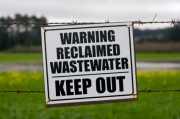U.S. Wastewater Infrastructure: Funding Issues and Aging Systems
Wastewater systems is the sixth topic in our U.S. infrastructure series. The American Society of Civil Engineers (ASCE) assigned the United States’ WASTEWATER infrastructure a grade of “D-” on their 2009 Report Card for America’s Infrastructure. Here we explore the funding issues that effect the aging treatment plants and waterways that make up our nation's wastewater infrastructure.


